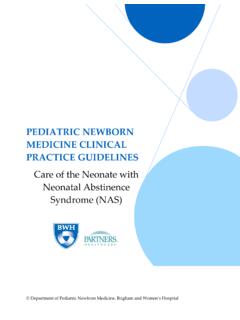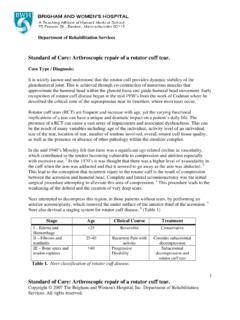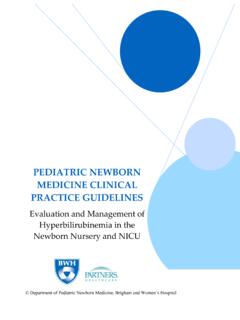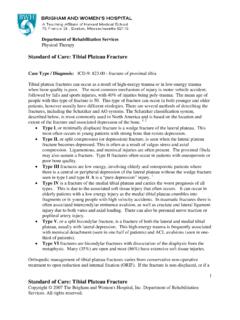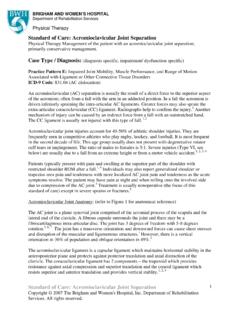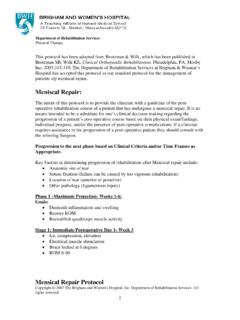Transcription of Standard of Care: Total Hip Replacement
1 Department of Rehabilitation Services Physical Therapy Standard of Care: Total Hip Replacement Inpatient Physical Therapy management of the patient following Total hip arthroplasty, hemiarthroplasty, hip resurfacing, or revision Total hip arthroplasty. ICD 9 Codes: Choose the primary diagnosis for the first ICD9 when entering charges. Use secondary supporting ICD9 codes depending upon impairments per individual patient. Table 1: ICD 10 Codes: may include, but are not limited to: Hip Osteoarthritis Juvenile Rheumatoid Arthritis affecting the hip Rheumatoid Arthritis with Rheumatoid Arthritis without Rheumatoid factor affecting the hip Rheumatoid Factor affecting the hip Osteonecrosis affecting the hip Hip Osteoarthritis secondary to hip dysplasia Femoral Neck Fracture Pathological femoral neck fracture Osteochondritis Dissecans affecting Hip Dislocation the hip Case Type / Diagnosis: This Standard of care applies to patients following hip hemiarthroplasty, Total hip arthroplasty (THA), and hip resurfacing as a result of disorders that include, but are not limited to.
2 Osteoarthritis (OA) Rotrusio Acetabuli Rheumatoid arthritis (RA) Arthritis associated with Paget's Avascular necrosis (AVN) Disease Congenital hip dysplasia Ankylosing Spondylitis Tumors/Osteosarcoma Juvenile Rheumatoid Arthritis Traumatic joint injuries This Standard of care serves as a guide for clinical decision-making for physical therapy (PT). management of this patient population at Brigham and Women's Hospital (BWH) acute care PT. services. Standard of Care: Total Hip Replacement Copyright 2015 The Brigham and Women's Hospital, Inc., Department of Rehabilitation Services. All rights reserved 1. The purpose of hip hemiarthroplasty, THA, and hip resurfacing is to reduce pain, restore function and correct deformity by improving the biomechanics of the hip joint.
3 This is done by replacing the damaged joint with a prosthetic implant, realigning the soft tissues, and eliminating structural and functional deficits. The Center of Disease Control and Prevention (CDC) reports that each year in the United States 332,000 Total hip replacements are performed1. In 2013. approximately 500 Total hip replacements were performed at BWH2. The demand for primary Total hip arthroplasties is estimated to grow by 174% by the year 2030, with the demand for revision procedures to grow by 137% within the same time frame3. Surgical Techniques: Total Hip Arthroplasty If both the acetabulum and the femoral head are damaged then a THA may be indicated. A THA. consists of a femoral and acetabular component. During a THA the hip is dislocated exposing the joint cavity and femoral head.
4 The deteriorated femoral head is removed. The acetabulum is prepared by cleaning and enlarging it with circular reamers of gradually increasing size1. The new acetabular shell is implanted securely within the prepared hemispherical socket. The acetabular socket can be made of metal, ultra-high molecular-weight polyethylene, or a combination of polyethylene backed by metal. The plastic inner portion of the implant is placed within the metal shell and fixed into place. Next, the femur is prepared to receive the stem. The stem portions of most hip implants are made of titanium- or cobalt/chromium-based alloys. They come in different shapes and some have porous surfaces to allow for bone in growth. A femoral neck osteotomy is performed, and the hollow center portion of the bone is cleaned and enlarged, creating a cavity that matches the shape of the implant stem.
5 The top end of the femur is smoothed allowing the stem to be inserted flush with the bone surface. If the ball is a separate piece, the proper size is selected and attached. Cobalt/chromium-based alloys or ceramic materials (aluminum oxide or zirconium oxide) are used in making the ball portions, which are polished smooth to allow easy rotation within the prosthetic socket. The ball is seated within the cup allowing proper alignment of the joint. Hip replacements may be cemented, cementless, or hybrid (a combination of cemented and cementless components), depending on the type of fixation used to hold the implant in place. Cemented THA are more commonly recommended for older patients, for patients with conditions such as RA, and for younger patients with compromised health or poor bone quality and density.
6 These patients are less likely to put stresses on the cement that could lead to fatigue fractures4. Figure 1: Total Hip Arthroplasty Standard of Care: Total Hip Replacement Copyright 2015 The Brigham and Women's Hospital, Inc., Department of Rehabilitation Services. All rights reserved 2. Hip Hemiarthroplasty If only one part of the joint is damaged or diseased, a partial hip Replacement , or hip hemiarthroplasty, may be recommended. In most instances, the acetabulum is left intact and the head of the femur is replaced, using components similar to those used in a Total hip Replacement . A hip hemiarthroplasty can be either a unipolar or bipolar prosthesis. The most common form of partial hip Replacement is unipolar1. In a unipolar prosthesis the head is fixed to the stem.
7 In a bipolar prosthesis there is an additional polyethylene bearing between the stem and the endoprosthetic head component5. Hip Resurfacing Hip resurfacing is a technique for hip arthroplasty that has recently emerged. BWH is one of the few New England Hospitals that offers hip resurfacing. The acetabular component is replaced similar to a Total hip Replacement , however the head of the femur is covered or "resurfaced" with a hemispherical component. This fits over the head of the femur and spares the bone of the femoral head and the femoral neck. It is fixed to the femur with cement around the femoral head and has a short stem that passes into the femoral neck1. Hip resurfacing conserves bone, restores the proximal femoral anatomy, and has lower wear rates.
8 A meta-analysis found that patients following hip resurfacing have better functional outcomes on the Western Ontario and the McMaster Universities Osteoarthritis Index (WOMAC) and Harris hip score (HHS) than those following THA6. Indications for hip resurfacing can include osteoarthritis, developmental dysplasia of the hip and avascular necrosis7. Hip resurfacing is an option for younger patients with more demanding lifestyles that would put them at higher risk for earlier failure of a THA. Certain patients, however, are at greater risk for requiring revision of resurfacing, including those with smaller femoral head size, older patients, and patients with developmental dysplasia7. Figure 2: THA vs. Hip Resurfacing Revision Total Hip Arthroplasty: Primary Total hip arthroplasties have a 95% survivorship at 10 years or greater.
9 With life expectancy growing and younger patients with higher activity levels undergoing THA, revision Total hip arthroplasties are an unfortunate necessity8. The incidence of revision THA in a fourteen month span of October 2005 to December 2006 was 51,345 patients in the United States9. The reasoning for revision varies and can be due to complications following THA along with other causes. These reasons for hip revision can be separated into three main categories: implant-related factors, patient related factors, and failures related to surgical technique. The most common indications may include the following: Standard of Care: Total Hip Replacement Copyright 2015 The Brigham and Women's Hospital, Inc., Department of Rehabilitation Services. All rights reserved 3.
10 Table 3: Reasons for Hip Revisions Implant-related factors: Surgical technique factors: Periprosthetic fracture Recurrent dislocation/instability*. Delamination of the porous coating Infection*. Osteolysis Malpositioning of components Aseptic loosening*. *= leading factors requiring revision Certain risk factors put patients at jeopardy for adverse events requiring revision THA. Patients with RA have a higher baseline risk for infectious disease compared to the general population. Patients with RA were found to have higher risk of prosthetic joint infections compared to patients with OA, resulting in a need for revision10. Sickle cell anemia, poor bone density, obesity, the male gender, and younger age are also risk factors that result in complications requiring revision Total hip replacement8.
